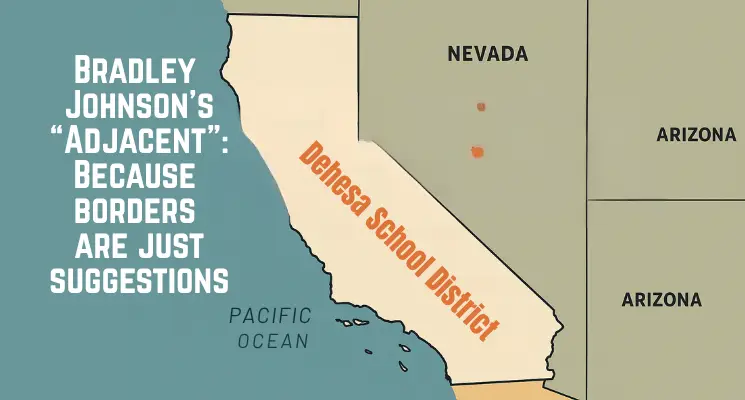According to a Bradley Johnson, Superintendent, and author of Dehesa School District’s letter to their auditor, Wilkinson, Hadley & King, based in El Cajon, he outlines his opinion that: LA County is considered “adjacent” to San Diego County. The reason? Because LA County includes Catalina and San Clemente Islands, and those islands are geographically near San Diego County in the Pacific Ocean. Therefore, Bradley Johnson argues, San Diego County is “close” or “near” to L.A. County—and voilà! Justification to enroll L.A.-based students under the independent study apportionment rules that require students to reside in a county “immediately adjacent.”
Time out! Wait….What? Say that again?
Bradley Johnson doesn’t just appear to be bending geographic rules—he seems to be island-hopping logic. To justify accepting student transfers from LA County, Superintendent Bradley Johnson suggests that because LA County includes both San Clemente Island and Catalina Island—and since those islands float roughly 78 miles (or 68 nautical miles, for the sea-legged among us) off the shore of San Diego County—that somehow makes San Diego and LA “adjacent.”
For those unfamiliar with Southern California commutes: the drive from San Diego to Los Angeles is, on a good day, 3.5 hours one way. With traffic, you’re looking at four hours or more. So to claim—via ocean, island, or imagination—that San Diego and Los Angeles counties are immediately adjacent isn’t just false. It appears to be a deliberate distortion designed to manipulate ADA (Average Daily Attendance) numbers and funnel public funds through Dehesa under the guise of online independent study charter school networks, very suggestive of old patterns.
Citing Catalina and San Clemente Islands as justification is a rhetorical lifeboat for a sinking argument. The state doesn’t fund school boat transportation, and students aren’t paddling from a military-controlled island to attend school. This isn’t oceanic adjacency—it’s looking like statutory sleight of hand.
So by all appearances sake this suggests an effort to twist the plain meaning of the law to inflate ADA counts and collect more taxpayer money—regardless of what the law actually says, it begs a larger question: Is this just a failure to understand language—or a willful abuse of it?
The Laws Are Clear….
Charter school law allows inter-county arrangements when counties are adjacent—a term that, legally and historically, means sharing a border. Dehesa and Los Angeles County are roughly 160 miles apart, with all of Orange County between them. That’s not adjacency—that looks like geographic fiction.
And while the Education Code doesn’t provide a specific statutory definition of “immediately adjacent,” courts don’t interpret laws in isolation. When statutory language is vague—especially in matters involving real property, jurisdictional boundaries, and school enrollment zones—California courts often rely on real property law and established canons of construction to interpret legislative intent.
Under California real property law, “adjacent” is commonly understood as:
“Immediately contiguous to or abutting a neighboring property, lot, or walkway, can include property across a right of way intersection, or an alleyway or other private egress.”
In other words: adjacent means physically touching, or proximately close in relationship. And if that’s the bar, then “immediately adjacent” means exactly that—direct, unbroken contact with nothing in between. Not “sort of nearby.” Not “floating in the same ocean.” And certainly not separated by Orange County and 160 miles of land.
State audit guidance doesn’t redefine “adjacent” as “contiguous”—because it doesn’t need to. The California Education Code is clear: a school district may only claim ADA apportionment for students who reside in the same county or in a county that is immediately adjacent—a term that plainly refers to counties that share a land border. The only proximity being claimed is between two offshore islands—Catalina and San Clemente Islands. And one of them—San Clemente Island—is a restricted military installation owned by the U.S. Navy, not even open to the general public. This isn’t a meaningful connection between counties—it appears to be a cartographic contortion designed to exploit a funding loophole.
From Adjacent to Absurd: When Legal Terms Become Rubber Bands
This is an example of kind of reasoning Johnson is using to justify enrolling thousands of out-of-county students. It’s not a stretch of language—it looks like full-blown dislocation. Rather than follow the statute—which uses the term “immediately adjacent,” traditionally understood to mean counties that share a border— Johnson seems to seek shelter in a loose interpretation that would make a Thesaurus blush. If this ever made it to the Supreme Court, one could imagine a rebuke be so sharp it would splinter the very foundation of this logic — striking it down with the kind of clarity reserved for only the most egregious statutory distortions, swift and unanimous— splintering this logic into precedent-setting debris, cited in law schools nationwide as the definitive case study in judicial eye-rolling.
And perhaps the real issue is Johnson is the Superintendent leading a K-8 educational institution without seeming to demonstrate a fundamental grasp of language— appearing to choose bureaucratic gymnastics over basic comprehension. More telling, as of the writing of this article, Johnson does not appear on the California Commission for Teacher Credentialing website, suggesting he lacks the REQUIRED qualifications per EdCode to even serve as a superintendent:
35028. A person shall not be eligible to hold a position as city superintendent, district superintendent, deputy superintendent, associate superintendent, or assistant superintendent of schools unless the person is the holder of both a valid school administration certificate and a valid teacher’s certificate, unless the person is employed as a deputy, associate, or assistant superintendent in a purely clerical capacity.
If the leader of a school district can’t distinguish a synonym from a statutory stretch, maybe the real lesson here is why credentials in education matter, especially when at the helm of them. Ironically, this isn’t graduate-level nuance—it’s the kind of distinction a 10th grader is expected to understand. If high school students are expected to know this information, shouldn’t the superintendent be held to a higher standard? Maybe it’s not the statute that needs reinterpretation—it’s the résumé.
So why does this matter?
Public education funding isn’t Monopoly money—it’s tied to precise legal definitions that ensure students are counted where they live, and funds are distributed fairly. ADA (Average Daily Attendance) apportionments hinge on where a student resides and whether that county is immediately adjacent to the one making the claim. More importantly, it is tied to California tax payers, Federal and State funding, all of which comes from every tax payer in this country.
The law isn’t dealing in metaphors or poetic license—it’s addressing physical, jurisdictional boundaries that determine who qualifies to receive public education funds through ADA (Average Daily Attendance) apportionment. If Dehesa School District wants to collect ADA funding for students who reside in Los Angeles County, they must demonstrate that Los Angeles County is immediately adjacent to San Diego County—not just nearby on a map, and certainly not via islands in the Pacific.
If we start playing games with language—stretching “immediately adjacent” to mean “kinda close” or “nearby because of proximity of offshore islands”—what stops someone else from turning that logic back on us?
What’s to prevent Los Angeles County from deciding that because San Diego is within proximity of LA’s offshore islands, LA should have a claim to San Diego County’s schools, its funding, AND its students? Could LA petition to absorb parts of San Diego County Schools under the same fuzzy logic Dehesa seems to be using? Once you detach legal terms from their plain meaning, there’s no brake pedal—only a steep hill and no guardrails.
Language in law is clear and specific for a reason. Once you rewrite definitions to suit a temporary agenda, you open the door to every kind of abuse—and set a precedent you’ll never be able to defend against.
If LA uses this same logic tomorrow and claims jurisdiction over San Diego County schools based on ‘proximity’—how do you say no, after saying yes?
It’s not about islands. It’s not about maps. It’s about the integrity of law—and the consequences when those entrusted to uphold it decide to rewrite it instead.
What’s Next?
If “immediately adjacent” includes Los Angeles County today, are you drafting charter petitions for the Moon tomorrow? Whispering sweet nothings of MOUs with NASA behind closed doors while mapping constellations “proximate” to San Diego? Because if proximity is all it takes, the sky’s no longer the limit—it’s just a zoning suggestion.
And clearly, in Dehesa, it seems everyone has a Right To Dream… even if those dreams are quietly approved in rooms the public never entered.
If you’re curious to see the original letters, and the auditor’s opinion on the subject:
Superintendent Letter to Auditor
Auditor Letter to Superintendent, Bradley Johnson regarding
Update/Clarification published 9/3/2025: https://eastof52.com/the-tone-zone-where-adjectives-get-a-23-point-traffic-stop/




